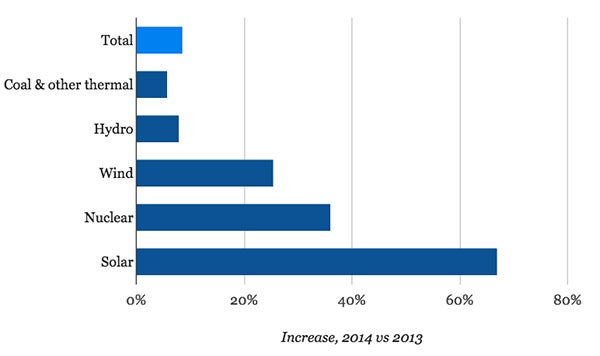This article was published in Scientific American’s former blog network and reflects the views of the author, not necessarily those of Scientific American
Stranger things have happened, but it looks like China’s coal use in 2014 actually declined, and not only that, local air pollution seems to have improved in Beijing. Previously I’ve discussed the imperative for China to turn around pollution before its cities not only become too polluted, but too congested and ultimately unlivable. Now, it seems there’s been some progress in reducing local air pollution, though not quite yet on congestion, as detailed earlier this May.
.jpg?w=600)
A smoggy day in Beijing, with chances of clearing up. Source: WikiMedia Commons, Kentaro Iemoto.
If you go through the data however, the image is not so much that things are good or much better, but rather that some very negative trends have at least abated. Some consider this nothing more than a blip for the year, whereas others would argue that 2014 is when China turned a corner on the twinned-trends of increasing local air pollution along with coal power capacity.
On supporting science journalism
If you're enjoying this article, consider supporting our award-winning journalism by subscribing. By purchasing a subscription you are helping to ensure the future of impactful stories about the discoveries and ideas shaping our world today.
The U.S. State Department is less rosy than Beijing’s Environmental Protection Bureau on improvements on air pollution, so while residents of Beijing might be happy to see things not getting worse, that certainly doesn’t mean things are good. Rates of lung cancer and the number of days classified as “hazardous” have only gone up, but with 500,000 old vehicles scrapped and efforts intensifying ahead of July 31st when the 2022 Olympics are decided, Beijing at least seems to be cognizant of the problems at hand, and is responding with near-term measures to decrease transport pollution as well as banning the sale and use of coal by 2020.
As for coal use decreasing in the power sector, the two are certainly linked, with coal accounting for 22.4% of Beijing’s PM 2.5. Coal use slumped 2.9% in 2014 compared to 2013, which is not a sea change in itself, but rather for what it represents: an abatement of the rampant growth in coal power installations in China. And if there is a chart of the moment, it could be the one below. If those trends hold, China’s new normal is here to stay.

Source: National Bureau of Statistics China. Chart by Carbon Brief.